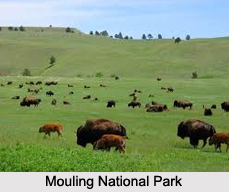 The state of Arunachal Pradesh is located in the north eastern part of India and is regarded as one of India"s 7 Sister States. This state has mountains, lakes, museums, Tawang (a town with a Buddhist monastery), Yomcha (limestone caves called `tapen uru`), etc. These, along with the scope for angling, boating, rafting, trekking and hiking draw a number of tourists to this state. Arunachal Pradesh also has national parks which are protected areas maintained to provide suitable habitats to the flora and fauna in the state.
The state of Arunachal Pradesh is located in the north eastern part of India and is regarded as one of India"s 7 Sister States. This state has mountains, lakes, museums, Tawang (a town with a Buddhist monastery), Yomcha (limestone caves called `tapen uru`), etc. These, along with the scope for angling, boating, rafting, trekking and hiking draw a number of tourists to this state. Arunachal Pradesh also has national parks which are protected areas maintained to provide suitable habitats to the flora and fauna in the state.
Namdapha National Park
Namdapha National Park is situated in the eastern Himalayan sub-region. It was established in the year 1974 and is spread over an area of about 1,985.23 square kilometers (766.50 sq mi). The core area covers an area of about 1808 square kilometers, whereas the buffer zone occupies 177 square kilometers. It has the distinction of being the third largest national park in India in terms of area and one of the richest areas in biodiversity in India. It has been categorized under both the Palearctic and Indo Malayan biogeographic areas. The area is blessed with a variety in vegetation type like tropical moist forests, montane forests, temperate forests, alpine meadows and extensive bamboo forests. Some of the other occupants recorded here are mammals (like clouded leopards, dholes, wolves and red panda), birds (like laughing thrushes, snowythroated babbler, green cochoa and pied falconet) and butterflies and moths. Lisu tribal people have a few settlements within the park. Around the park are Chakma, Tangsa and Singpho settlements.
It has been categorized under both the Palearctic and Indo Malayan biogeographic areas. The area is blessed with a variety in vegetation type like tropical moist forests, montane forests, temperate forests, alpine meadows and extensive bamboo forests. Some of the other occupants recorded here are mammals (like clouded leopards, dholes, wolves and red panda), birds (like laughing thrushes, snowythroated babbler, green cochoa and pied falconet) and butterflies and moths. Lisu tribal people have a few settlements within the park. Around the park are Chakma, Tangsa and Singpho settlements.
Mouling National Park
Mouling National Park is located over the Upper Siang district and parts of the West Siang and East Siang district. It was established on December 30, 1986 and is spread over an area of about 483 square kilometers (186 sq mi). It has the distinction of being one of the 18 biodiversity hotspots of the world. Extreme humidity prevails in the park. The park is blessed with heavy rainfall (2343 mm annually) and it has no well-defined dry season. Winter snowfall also graces the park. The terrain of the park is rugged and a number of small brooks and streams enrich the landscape. The park has dense vegetation on mountainous land with steep slopes. Flora examined in the park are a mix of tropical wet evergreen, semi evergreen, subtropical broad-leaved hill forests, montane wet temperate forests and bamboo. Some of the other occupants recorded here are mammals (like elephant, tiger, panther, wild buffalo and red panda), birds (like tragopan, green cochoa, forest eagle and monal pheasants) and reptiles (Indian python).



















